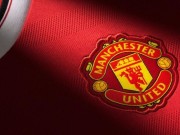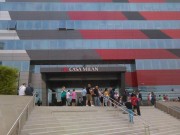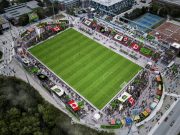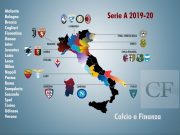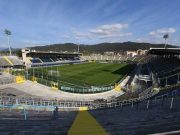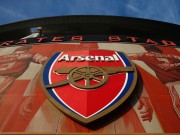ARTICLE BY CHARLES GOULD, CEO OF RETEXO
If one asks around European clubs what their main focus is, the majority will talk about television revenues, commercial partnerships, ticket sales, merchandise sales and digital monetization. Clubs will also discuss the opportunity to develop new commercial assets and commercializing this inventory to create ancillary revenue streams.
By any reckoning the football landscape has changed and although its commercial potential has never been greater, growing club brands and commercial revenues are concepts mainly the preserve of the big clubs. Aside from the forthcoming television revenues available on participation in a major European league, a small club that gains promotion to a major European league is less likely to be able to commercialize itself at the rate of larger, storied clubs.
When asked about business priorities, fewer clubs talk about creating financial assets and increasing their enterprise value by using the raw materials available in any location – principally the local population. No club has the excuse that it cannot develop its own playing assets over the medium to long-term by successfully analyzing and empowering its surrounding area. Producing players through a club’s academy is a (relatively) low-cost exercise and one that yields more plentiful and robust financial assets (players) than commercial inventory, if addressed properly.
Italy as a country has slipped badly in its elite player production figures over the past generation. During the 2019/2020 season Serie A had a composition within its registered squads of 39.5% Italian players, compared with La Liga’s 60% Spanish players, Ligue 1’s 53% French players, Bundesliga’s 43% German players and ahead only of the Premier League’s 37% British players. Italy has the population to address its player production decline and evidence of this reverse is already present.
A solid academy structure and operations are fundamental as a baseline operation to any club and the simplest way to develop its future. In fact, the academy is, and should be empowered as, the lifeblood of any club. The price for not addressing a healthy academy is the consequent obligation to acquire post-academy players, often at premium prices.
Building an academy requires three key components to be brought together in lockstep – academy recruitment, methodology and pathway. Academy scouting is a different art from First Team scouting – the players are rarely physically developed and have not yet had to resist the inevitable off-pitch challenges to their development.
The methodology applied by clubs is as important as having acquired the best possible players at the outset. Five major examples bear out how important methodology is for building the academy properly.
Athletic Bilbao – the club recruits exclusively Basque players, or players of Basque descent to its academy and First Team. The population of País Vasco is slightly above 2M. Despite its self-imposed restrictions, Athletic Bilbao regularly produces elite players and in 2018 became the first club to sell two academy graduates, Aymeric Laporte to Manchester City and Kepa Arrizabalaga to Chelsea, for more than €50M each.
Olympique Lyonnais – quite aside from the incredible work the club does in its post-academy player recruitment, Lyon, based in France’s Auvergne-Rhône-Alpes region has produced a number of elite players from the region alone, including Karim Benzema, Corentin Tolisso, Alexandre Lacazette, Nabil Fekir, Samuel Umtiti, Willem Geubbels and Houssem Aouar. Almost all of these players are full French internationals and Umtiti, Tolisso and Fekir are all world champions.
*Samuel Umtiti was born in Cameroon but raised in Villeurbanne in the Lyon Metropolis
Uruguay – despite being a country with only a population of 3.5M people, Uruguay consistently produces elite players, as shown in the emergence of the current generation of Darwin Núñez, José Giménez, Fede Valverde, Lucas Torreira, Rodrigo Bentancur and Ronald Araújo.
Croatia – World Cup finalists in 2018, Croatia has a population of just over 4M people. The majority of successful academy development is from G.N.K. Dinamo Zagreb, centering on the capital region of Zagreb, with significant amounts of players from Split and consequently its main club, H.N.K. Hajduk Split.
There is then the consideration of the pathway. A club such as Benfica provides its youth players necessary playing time to embed into the First Team and the platform to attract interest from foreign clubs.
Benfica – notable recent academy graduates from or near to Lisbon include Gonçalo Guedes, Renato Sanches, Bernardo Silva, João Cancelo, Ruben Dias, Gedson Fernandes and Florentino Luis.
A benefit of successful academy operations, among others, is the production of local players, ideally fans, but at least with the knowledge and appreciation of what playing for that club means. Analysis of elite home-grown players and their presence within successful squads demonstrates the type of culture they help to foster at their clubs, something that is much harder to achieve with a transient, foreign playing staff.
Interestingly, both France and Portugal as major football nations have found ways to harness the immigrant communities present within their countries. France is home to many first- or second-generation families from North Africa, West Africa and francophone Caribbean islands – Guadeloupe and Martinique being prominent examples even if they are technically departments of France.
Portugal has been home for several generations to Cape Verdean, Angolan and Mozambican immigrant communities, which it has successfully woven into its football fabric.
Although Italy as a country does not have the same kind of colonial history as the English, French, Spanish and Portuguese, it has a significant diaspora and increasing domestic immigration from African countries. At the time of writing, these communities have not yet been integrated into the Italian footballing infrastructure to the same degree as in France or Portugal, owing to the fact that most of this immigration has been more recent than in other countries and there are signs that this is beginning to change at Italian youth team level.
Regardless of these shifting demographics and the opportunities they represent, the examples listed give ample proof that any club in any region is able to produce elite playing talent by being well organized, scouting effectively, developing these players and offering them pathways to their First Teams.
These types of operations are not restricted to elite clubs. In fact, smaller clubs often have advantages over larger clubs due to the fact that they can guarantee high-potential players the playing time they desire – something that is increasingly hard to come by at Europe’s biggest clubs.
Running a healthy academy should be a priority for any club and is the best pathway for asset creation on a budget. Forward thinking owners will begin to realize that structuring this part of the club correctly is their best chance of generating stabilizing revenues and phenomenal capital gains while supplementing their First Team squads.
In mid-2019, Retexo embarked upon a project to analyze the output of global academies to European leagues and understand the best practices that enabled these outputs. The message was clear – many clubs which are successful are so despite themselves and organizational charts and reporting lines shift constantly. Conversely, the clubs which have successfully sustained proficient academies were those which had set plans and executed unwaveringly against these plans by empowering proficient, intelligent individuals in lean structures with clear access to their clubs’ decision makers.
With the increasing amount of capital required for club acquisitions and the expectation for return on investment, the academy will continue to gain prominence as the heartbeat of ambitious clubs, not just through a technical but an increasingly financial lens.


